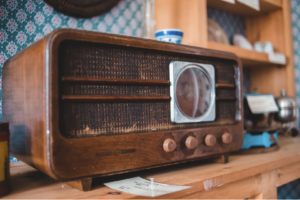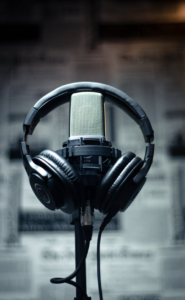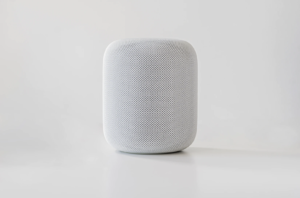In a world of voiceover, you’d think all pipes would be created equal if they sounded right for the job, right? Not always. Our industry has often been very male heavy. For instance, most of the ‘voice of God’ type work goes to men. There are many reasons why this is the case, and the biggest one is the typical patriarchal thinking of our society. Studies have been done that show how listeners typically trust a male voice more than a female one. Resonant, lower pitched voices pique this niche well, coming across as authoritative and trustworthy. But an interesting nuance of technology has helped shape these already-existing perceptions throughout the last hundred years of technology’s march.
Back in the Day

In the early days of radio, only AM stations were on the air. Broadcasters proliferated, and then the FCC came about to regulate frequencies. To make a long story short, the frequencies chosen for these early radio stations were in a particular band that did not transmit the higher parts of women’s voices well. This particularly affected the consonants, making women’s voices sound distorted and unpleasant. In addition, since there was a wide perception of women’s voices being softer at the time, the engineers would turn up the volume when a woman stepped to the mic, causing the distortion to be even worse. Unfortunately, rather than viewing this issue as a fault in the way the equipment was made, broadcasters and engineers of the time simply believed that women’s voices had biological and psychological faults that made them unsuitable for broadcast work. Women at the time were generally given the advice that they should speak unemotionally and at a lower pitch, which made their voices sound stiff and artificial. Even the march of technology has not significantly altered the embedded preferences, since FM radio with wider frequencies available did not become equally popular until the 1970’s. And as various kinds of speakers and compression algorithms affect higher pitches more strongly, continuing to make women’s voices sound thin and tinny.
This century’s worth of disdain and distortion for the female voice has had lasting effects, and doubtless has heavily affected the proportion of voiceover jobs alloted to women, and probably even the studies that give male voices as more ‘trustworthy’. And if you consider the women that do high profile work, they mostly uniformly have lower, melodious sounding voices-to sound ‘better’ in this atmosphere of distortion and misunderstanding. Voice talents with higher pitched voices often specialize in children’s parts.
“In a World…”
In the movie trailer world, producers admit that they just don’t often consider women for the parts cast. John Long of Buddha Jones Trailers says “…his company had worked on dozens of campaigns a year, “and as much as everyone talks about wanting to be innovative and do unexpected things, the idea of a female voice doesn’t come up that often,” he said. “It’s really not part of the formula. Maybe that’s our own shortsightedness.” Actress and Director Lake Bell explored this dichotomy in her 2013 comedy film, “In a World…” in which Lake’s character competes for a trailer part with male voice talent and lands the job. Lake’s character Carol delivers a very fine performance, and she is able to use the role as an asset in her coaching career to encourage new students that they can find a way out of the typical gender boxes for voice roles. Lake was fascinated by the preponderance of male voices in trailer work, with the exception of using Melissa Disney for Gone in 60 Seconds in 2000. She was then inspired to write the movie where a woman had a chance to overcome this prejudice and gain a trailer part.
Although voiced movie trailers are less common than they once were-studios seem to prefer trailers that show the film as itself rather than someone vocally introducing it-there are still plenty of parts that have to do with a ‘voice of God’ type sound.

Actress/Producer/Casting director Joan Baker weighs in on the nature of our internal biases and how we can all make choices to discard them and move forward in the nature of sound.“All of us in the industry have the opportunity to discard our biases against female voices, challenge the old voice of God assumptions, and look upon all voice actors with open minds. It’s not a matter of forcing an even split between men and women; that would be as arbitrary as forcing painters to use equal amounts of all colors in their paintings. All I’m asking is that we do what we can to eliminate the thorn of bias and let the chips fall where they may.
Progress is slow, but change is happening
As I said earlier, things are slowly changing. Advertisers are getting smarter about what people want, how they want it, and who they want to hear it from. It’s a slow evolution, but it can be seen emerging as women land roles of mastery, leadership, power, and responsibility. Of course, the voice of God is not gender-specific. In my opinion, the concept is light years beyond the anatomy that produces the tambour of male and female voices. If we want to use “voice of God” as a term, it has to be metaphoric: a voice that moves mountains with the authority of heart, mind, and spirit. It’s the stuff of life, energy, and inspiration. Babies have it when they cry out, long before they can form words. When a baby cries out, you are absolutely compelled to give it your undivided attention. It wakes something up inside you that can’t be appeased, except through your attendance to its call. This is the genderless power of the human voice. It’s bigger than voice acting, but as far as voice acting goes, producers and actors need to catch up to this reality and act accordingly.
TV audiences are ready for a shift
 Joan is right, and the industry is changing outside of movie trailers quicker than within. TV is it’s own frontier, and it’s doors are a little wider open. “In television many cable channels regularly aim programming at women, and there has been more latitude in the use of female voices. “We’re all trying to make shows that cut through the clutter and stick out,” said Tim Nolan, senior vice president for marketing at Lifetime Networks. “But for me it’s less about being authoritative and more about being relatable. It’s a big turnoff for TV consumers if they think they’re being sold. Whether the show’s about fashion or drama or reality, it’s about which voice is telling those stories better.”
Joan is right, and the industry is changing outside of movie trailers quicker than within. TV is it’s own frontier, and it’s doors are a little wider open. “In television many cable channels regularly aim programming at women, and there has been more latitude in the use of female voices. “We’re all trying to make shows that cut through the clutter and stick out,” said Tim Nolan, senior vice president for marketing at Lifetime Networks. “But for me it’s less about being authoritative and more about being relatable. It’s a big turnoff for TV consumers if they think they’re being sold. Whether the show’s about fashion or drama or reality, it’s about which voice is telling those stories better.”
In testing “One Born Every Minute,” a Lifetime series set in an Ohio maternity ward, the channel found that audiences responded most favorably to a voice-over by Jamie Lee Curtis, even before they recognized her, Mr. Nolan recalled, adding: “One woman said that the voice understood who she was.”
Technology, cultural bias, and the heavy hand of perception has left women’s voices out of certain genre for a very long time. Many of these things have an opportunity to shift now with the trend to look at representation, and relatability as being the cornerstones of good voicing. Let’s hope we can all work together so that balanced representation doesn’t take another hundred years!
 For anyone growing up in the last 60 years or so, computer voices are a part of the early media you consume. The computer voice on Star Trek was female. The robot Nanny in the Jetsons was female. Many folks either had or selected female voices for their GPS. Now, for anyone with an iPhone, Siri, another female voice is a button touch or spoken word away. Alexa is another female standard option, and Cortana is named for a (barely dressed) character from the video game Halo. But why are there so many female computer voices, and why in particular do so many assistant type programs have one?
For anyone growing up in the last 60 years or so, computer voices are a part of the early media you consume. The computer voice on Star Trek was female. The robot Nanny in the Jetsons was female. Many folks either had or selected female voices for their GPS. Now, for anyone with an iPhone, Siri, another female voice is a button touch or spoken word away. Alexa is another female standard option, and Cortana is named for a (barely dressed) character from the video game Halo. But why are there so many female computer voices, and why in particular do so many assistant type programs have one? Google has an interesting bit of history behind it’s earlier generation of female voices. At the time the company began its signature voice, they originally intended to create both a male and female option. However, an engineer at Google says, “…
Google has an interesting bit of history behind it’s earlier generation of female voices. At the time the company began its signature voice, they originally intended to create both a male and female option. However, an engineer at Google says, “…